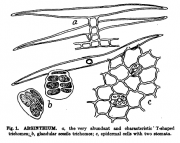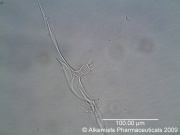Artemisia absinthium (leaf)
(→add quote from Wikipedia) |
(→add correct citation for wikipedia quote) |
||
| Line 1: | Line 1: | ||
=Introduction= | =Introduction= | ||
| − | ''Introduction from http:// | + | ''Introduction from Wikipedia, the free encyclopedia (http://en.wikipedia.org/wiki/Artemisia_absinthium, retrieved 02/13/2012).'' |
Artemisia absinthium (absinthium, absinthe wormwood, wormwood, common wormwood, green ginger or grand wormwood) is a species of wormwood, native to temperate regions of Eurasia and northern Africa. | Artemisia absinthium (absinthium, absinthe wormwood, wormwood, common wormwood, green ginger or grand wormwood) is a species of wormwood, native to temperate regions of Eurasia and northern Africa. | ||
| Line 7: | Line 7: | ||
It grows naturally on uncultivated, arid ground, on rocky slopes, and at the edge of footpaths and fields. | It grows naturally on uncultivated, arid ground, on rocky slopes, and at the edge of footpaths and fields. | ||
| + | |||
| + | ''The quoted text in this section was licensed for use under the Creative Commons ShareAlike License, version 3.0: http://creativecommons.org/licenses/by-sa/3.0/'' | ||
=Macroscopic Entries= | =Macroscopic Entries= | ||
=Microscopic Entries= | =Microscopic Entries= | ||
Revision as of 20:44, 13 February 2012
Contents |
Introduction
Introduction from Wikipedia, the free encyclopedia (http://en.wikipedia.org/wiki/Artemisia_absinthium, retrieved 02/13/2012).
Artemisia absinthium (absinthium, absinthe wormwood, wormwood, common wormwood, green ginger or grand wormwood) is a species of wormwood, native to temperate regions of Eurasia and northern Africa.
It is a herbaceous, perennial plant with fibrous roots. The stems are straight, growing to 0.8-1.2 m (rarely 1.5 m) tall, grooved, branched, and silvery-green. The leaves are spirally arranged, greenish-grey above and white below, covered with silky silvery-white trichomes, and bearing minute oil-producing glands; the basal leaves are up to 25 cm long, bipinnate to tripinnate with long petioles, with the cauline leaves (those on the stem) smaller, 5–10 cm long, less divided, and with short petioles; the uppermost leaves can be both simple and sessile (without a petiole). Its flowers are pale yellow, tubular, and clustered in spherical bent-down heads (capitula), which are in turn clustered in leafy and branched panicles. Flowering is from early summer to early autumn; pollination is anemophilous. The fruit is a small achene; seed dispersal is by gravity.
It grows naturally on uncultivated, arid ground, on rocky slopes, and at the edge of footpaths and fields.
The quoted text in this section was licensed for use under the Creative Commons ShareAlike License, version 3.0: http://creativecommons.org/licenses/by-sa/3.0/
Macroscopic Entries
Microscopic Entries
|
|
HPTLC Entries
Other Points of Interest
Cite error: <ref> tags exist, but no <references/> tag was found

